The state of latvian commercial websites: a technical audit of 29,633 sites
This study analyzes 29,633 Latvian commercial websites to assess their technical performance, security, and SEO readiness.
The results show that most sites lack key optimizations, with only a tiny fraction meeting modern best practices.
The research is based on technical analysis of 29633 commercial websites in Latvia. All data are taken from open sources.
Why? To understand the current technical state of these sites and identify growth opportunities to boost competitiveness.
According to statistical data from the Latvian domain name registrar NIC, the total number of registered and active sites in Latvia at the time of writing was 127,999. This research includes 29,633 commercial websites, accounting for 23% of all active sites.
It is important to note that this study focuses exclusively on commercial websites. It does not cover personal websites, blogs, or other types of web resources. A commercial site is defined as one that is affiliated with a company in some way.
The analysis included server connections, technologies used, website loading speed, and HTML page structure.
20 Key Findings:
- Only half of the sites are hosted in Latvia; 40% are located elsewhere in the EU and 10% in the USA.
- Nano is the most popular hosting provider in Latvia.
- Only 5% of sites are protected against DDoS attacks.
- Only 50% of sites have SSL/HTTPS enabled.
- Over 30% of sites take more than one second to load.
- 20% of sites lack a robots.txt file.
- Only 20% of sites have a sitemap.
- Web analytics is present on 60% of sites.
- One in three sites is built with WordPress.
- Two-thirds of sites are mobile-responsive.
- A third of sites still use outdated meta keywords.
- 1% of sites still include Flash elements.
- Only 8% of sites use the theme-color meta tag.
- Just one-third of sites are optimized for social networks.
- 25% of sites use Schema.org structured data.
- Only half of the homepages include an H1 title tag.
- Mailto links appear on 35% of sites; tel links on just 20%.
- Latvian is the main language on 66% of sites.
- Only 8% of sites are free from technical errors.
- Competitiveness is relative across the landscape.
In which countries are Latvian sites physically located?
Most Latvian sites (48%) are hosted within Latvia. 40% are located in other European countries, and 10% are hosted in the USA. The remaining 2% are distributed globally.
Latvia, Germany, and the Netherlands are the top three hosting locations, collectively hosting 69% of all analyzed sites. Less common hosting countries include Georgia, Taiwan, Kazakhstan, North Korea, and Papua New Guinea.
Note: These statistics are based on IP geolocation of hosting servers. However, due to the increasing use of CDN (Content Delivery Networks), which serve content from nodes closest to users, these figures may not reflect actual content delivery geography. Learn more about CDN technologies from Cloudflare.

| No. | Country | Number of Sites |
|---|---|---|
| 1 | Latvia | 48% |
| 2 | Germany | 11% |
| 3 | Netherlands | 10% |
| 4 | UK | 6.47% |
| 5 | Canada | 4.91% |
| 6 | USA | 4.65% |
| 7 | Lithuania | 2.86% |
| 8 | Denmark | 2.01% |
| 9 | France | 2% |
| 10 | Estonia | 1.65% |
| 11 | Russia | 1.53% |
| 12 | Ireland | 1.36% |
| 13 | Finland | 0.79% |
| 14 | Sweden | 0.41% |
| 15 | Poland | 0.29% |
What are the most popular hosting companies in Latvia?
The top hosting providers by number of hosted sites are Nano, Digitalas Ekonomikas Attistibas Centrs, and the Institute of Mathematics and Computer Science of the University of Latvia. Together, they host around 25% of all commercial sites.
Note: Hosting provider data was unavailable for over 40% of IPs, which are categorized under "others".
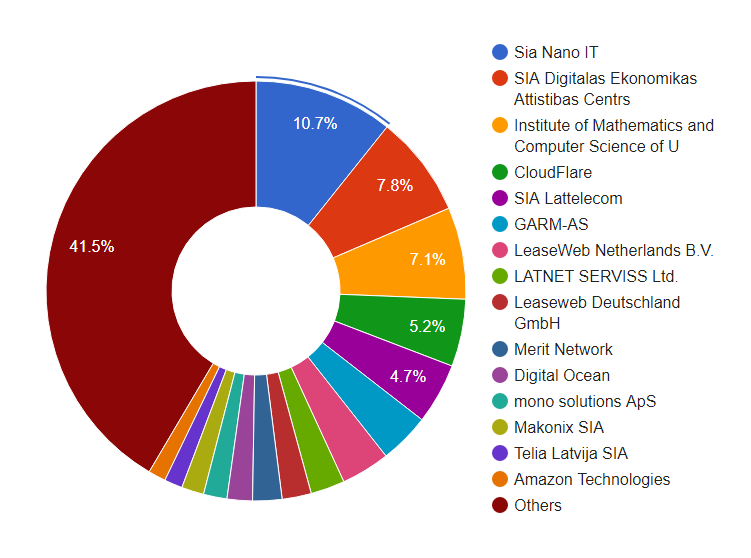
| No. | Hosting Company | Sites (%) |
|---|---|---|
| 1 | Sia Nano IT | 10.73% |
| 2 | SIA Digitalas Ekonomikas Attistibas Centrs | 7.82% |
| 3 | Institute of Mathematics and Computer Science | 7.08% |
| 4 | CloudFlare * | 5.19% |
| 5 | SIA Lattelecom | 4.68% |
| 6 | GARM-AS | 3.88% |
| 7 | LeaseWeb Netherlands B.V. | 3.75% |
| 8 | LATNET SERVISS Ltd. | 2.63% |
| 9 | Leaseweb Deutschland GmbH | 2.25% |
| 10 | Merit Network | 2.25% |
| 11 | Digital Ocean | 1.95% |
| 12 | mono solutions ApS | 1.81% |
| 13 | Makonix SIA | 1.72% |
| 14 | Telia Latvija SIA | 1.40% |
| 15 | Amazon Technologies | 1.35% |
- Cloudflare hides the real server IP, making it impossible to determine the hosting provider.
How many sites in Latvia are protected from DDoS attacks using Cloudflare?
Cloudflare offers not only a free SSL/HTTPS certificate and DNS management, but also DDoS protection and security features.
It masks the real IP address and uses algorithms to block malicious traffic.
In Latvia, only 5.19% of sites have Cloudflare installed.
Cloudflare provides a free plan and is easy to install.
How many sites in Latvia use a secure HTTPS / SSL certificate?
Currently, 53% of Latvian websites have a valid SSL certificate installed. The remaining 47% still use HTTP.
Google recommends using HTTPS for better security and search ranking.
Opportunity: Free solutions like Cloudflare make HTTPS adoption easier, even though setup may require some effort.
How fast do Latvian sites load?
When a user accesses a site, the server prepares the content as HTML for the browser to render.
Google expects servers to respond in under 200 milliseconds.
7.18% of sites meet this target. About 40% load within 500 ms, and 31% take more than 1 second.
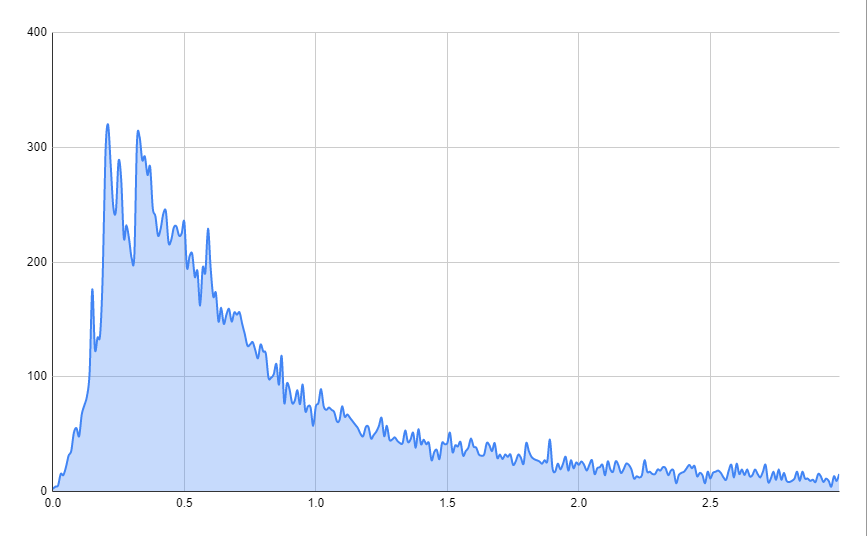
TTFB (Time to First Byte) is another key ranking metric. Google recommends a response time under 200 ms.
9% of Latvian sites meet this standard, while 44% load within 500 ms and 27% take more than 1 second.
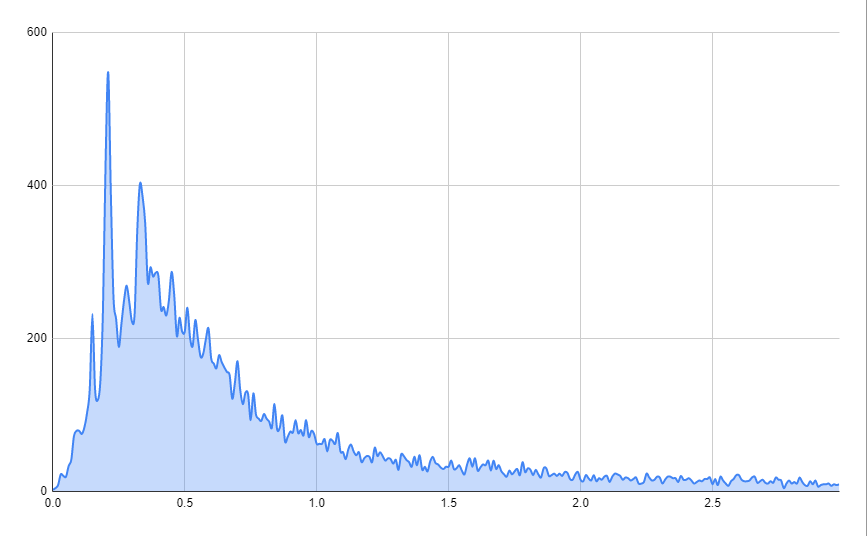
What size are the main pages of Latvian sites?
The recommended HTML page size is under 100KB.
84% of Latvian sites follow this recommendation. Only 1% have pages sized between 200–500KB.
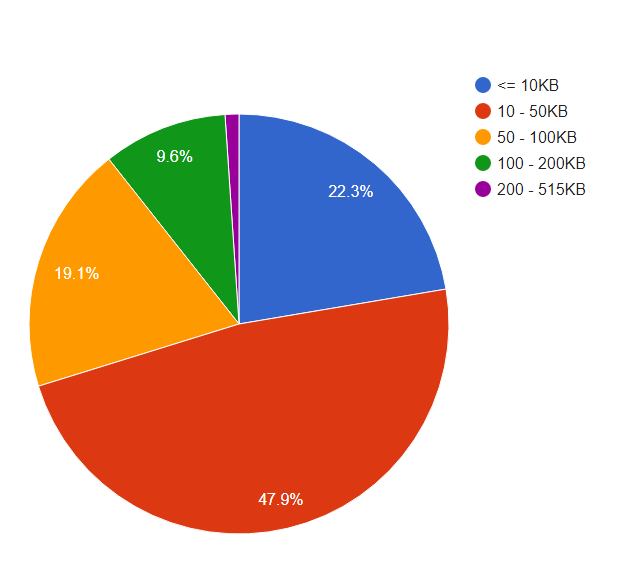
How many Latvian sites have a robots.txt file?
The robots.txt file tells search engines which parts of a site to crawl or ignore.
79% of Latvian sites have a robots.txt file. The other 21% either lack it or have formatting issues.
But what about the sitemap?
Sitemaps list all pages of a site and are often linked in the robots.txt file.
Only 26% of sites with a robots.txt file include a sitemap link. Overall, just 20% of Latvian sites link to a sitemap.
What servers are Latvian sites installed on?
The most popular web servers:
- Apache – 56%
- Nginx – 34%
- IIS – 4%
What operating systems are used:
| Operating System | Sites (%) |
|---|---|
| Ubuntu | 7.34% |
| Debian | 3.41% |
| CentOS | 2.36% |
| UNIX | 1.10% |
| FreeBSD | 0.41% |
| Windows Server | 0.31% |
| Fedora | 0.29% |
What web analytics do Latvian sites use?
60% of sites use some form of web analytics. Among them:
| System | Sites (%) |
|---|---|
| Google Analytics / Tag Manager | 48% |
| Facebook Pixels | 7.4% |
| Yandex.Metrika | 2% |
| TrackJs | 1.26% |
| StatCounter | 0.54% |
| Liveinternet | 0.47% |
What content management systems are installed on Latvian websites?
Top CMS platforms:
| CMS | Sites (%) |
|---|---|
| WordPress | 27.55% |
| Joomla | 5.31% |
| Wix | 2.31% |
| Drupal | 1.97% |
| TYPO3 | 0.91% |
| Weebly | 0.58% |
| RCMS | 0.54% |
| CMS Made Simple | 0.42% |
| 1C-Bitrix | 0.40% |
| October CMS | 0.36% |
| MODX | 0.22% |
The most popular CMS for Latvian online stores
Top platforms: WooCommerce, OpenCart, and PrestaShop – collectively powering 7% of sites.
Magento, despite global popularity, is used on only 0.66% of Latvian sites.
What frameworks are used to create Latvian sites?
Most common languages: PHP (66%), Python (1%), Java (0.5%).
Top backend frameworks:
| Framework | Sites (%) |
|---|---|
| Microsoft ASP.NET | 3.92% |
| Yii | 3.76% |
| Ruby on Rails | 0.66% |
| CodeIgniter | 0.56% |
Top JavaScript frameworks:
| Framework | Sites (%) |
|---|---|
| jQuery | 68.33% |
| Underscore.js | 2.27% |
| Vue.js | 1.25% |
| React | 1.14% |
| AngularJS | 0.25% |
Content Delivery Network usage:
| CDN | Sites (%) |
|---|---|
| Cloudflare | 4.3% |
| Amazon | 2.6% |
| Akamai | 0.23% |
Popular widgets and other elements
| Widget | Sites (%) |
|---|---|
| reCAPTCHA | 0.12% |
| Google Maps | 6.83% |
| Mailchimp | 0.27% |
| Font Awesome | 18.88% |
| Google Fonts | 43.25% |
| 12.56% | |
| 2.00% | |
| AddThis | 1.16% |
Despite the fact that Google Plus shut down in April 2019, its widgets are still present on 289 Latvian websites.
Technical SEO – SEO Site Optimization
Below are aspects of technical SEO based on Google’s best practices and widely accepted coding standards.
title Headers for Latvian Sites
Google recommends that page titles not exceed 60 characters. This doesn't mean titles should be one word long - on the contrary, it's best to make full use of that character limit.
This recommendation is followed by 81% of Latvian websites. Another 12% have title lengths between 60 and 100 characters, while 7% exceed that by a wide margin - some reaching up to 1000 characters.
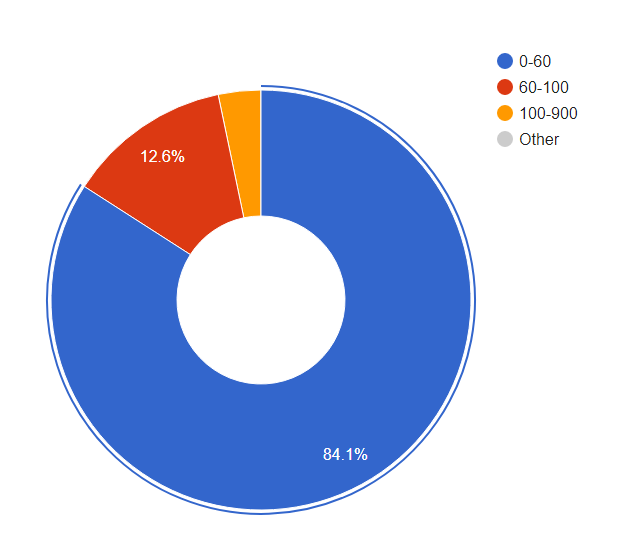
The site with the longest title is 1fotobode.lv, with 6372 characters.
Brief Description Using the meta description Tag
Google advises keeping meta description tags between 155–160 characters to concisely describe the page content.
Only 47% of Latvian sites include this tag at all. Just 5.65% fully utilize the optimal character range. Meanwhile, 35% remain under 160 characters, 9.8% exceed it (up to 320 characters), and 1.84% have extreme lengths - some spanning thousands of characters.
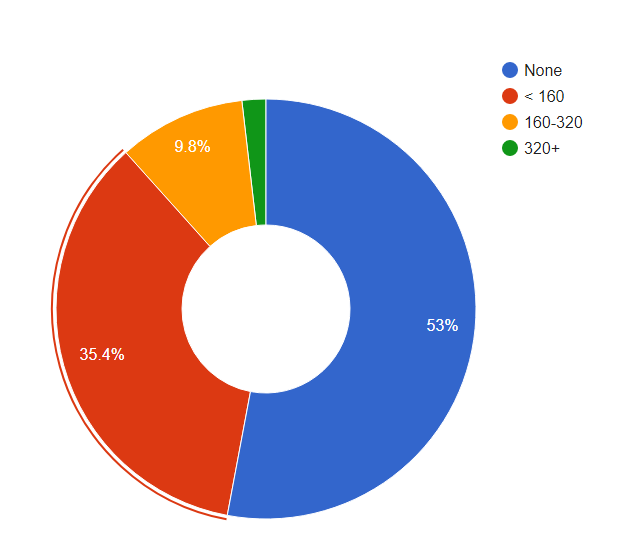
The longest meta description is found on junkersserviss.lv with 36844 characters.
Mobile-Friendliness of Latvian Websites
Although Google introduced mobile-first indexing in 2018, only 67% of Latvian sites have mobile versions. The remaining 33% are not adapted for mobile devices.
Use of Deprecated meta keywords
Although ignored by Google for over a decade, 29% of Latvian sites still use the meta keywords tag. While 80% of these stay under 255 characters, 17% range from 255–1000, and 3% exceed 1000 characters.
- 23611 characters – northouse.lv
- 36926 characters – junkersserviss.lv
336 Sites Still Use Flash
Flash is obsolete, yet 336 Latvian websites still use it - typically for 1–4 banners per site. These are blocked by modern browsers like Chrome.
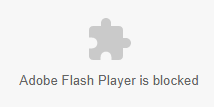
Adoption of meta theme-color
Only 8% of Latvian sites use this attribute, which allows for a more personalized experience on mobile browsers like Facebook.

Open Graph and Social Media Sharing
Just 32% of sites include Open Graph markup for enhanced link previews on platforms like Facebook.
What About og:twitter?
Despite Twitter's 13.12% share in Latvia’s social media landscape, only 0.6% of sites (about 140) implement Twitter card markup.
Schema.org Structured Data
Structured data helps search engines better interpret web content. Only 25% of Latvian websites use schema.org markup.
Use of H1 Main Headings
Just 50% of Latvian homepages include an H1 header. Another 6% use it twice, while 11% have more than three.
- 100 – jurmalassiltums.lv
- 110 – jal.lv
- 159 – sushistation.lv
Header Hierarchy Overview
| Title | Present, % | Avg. Character Length | Avg. per Page |
|---|---|---|---|
| H1 | 50% | 98 | 1.20 |
| H2 | 56% | 93 | 3.35 |
| H3 | 45% | 87 | 3.36 |
| H4 | 25% | 95 | 1.71 |
| H5 | 12% | 124 | 0.79 |
| H6 | 5% | 141 | 0.29 |
143 sites use all six header levels, but only 82 of them follow the correct hierarchy with a single H1.
Image Usage on Latvian Sites
Images are used on 90% of homepages. Most pages feature 1–10 images, followed by 10–30. Fourteen sites exceed 500 images.
Top image-heavy site: danfomasters.lv with 1756 images.
Image SEO: alt and title Attributes
Only 0.7% of images have both attributes. alt is present on 80.9% of images, and title on just 18.4%.
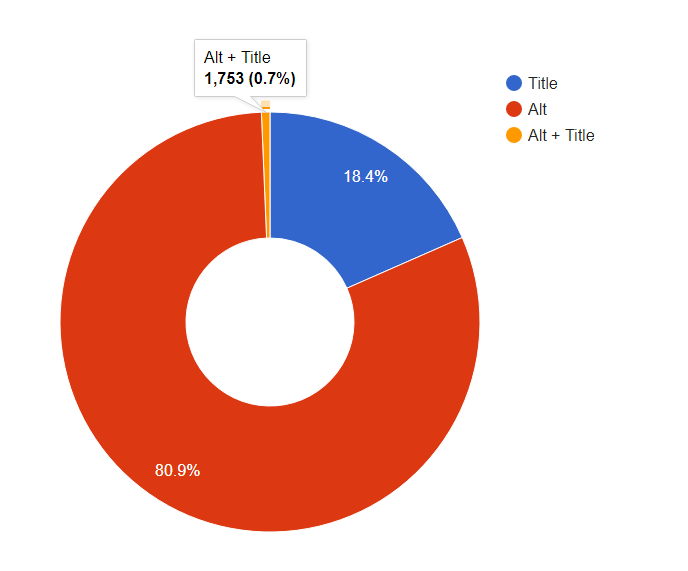
Internal Links
According to best practices, no more than 100 links per page is ideal. 78% of Latvian websites follow this. About 6% have no links at all, and 37 sites contain over 1000 links on a single page.
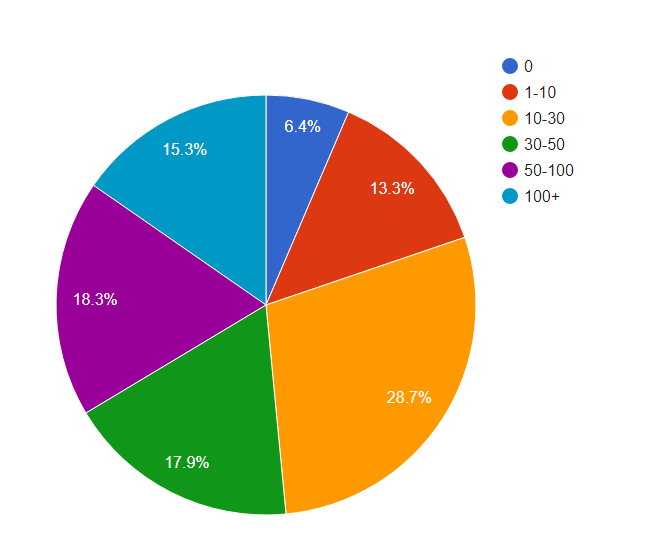
Contact Links
mailto:used on 35% of sitestel:used on 20% of sites
CSS and JS File Usage
On average, Latvian sites use 4.4 JavaScript files and 12.7 CSS files. Despite best practices, 82% still rely on inline CSS, which can impact performance.
Code Line Count
Minimizing HTML is a recommended optimization, yet only 17% of Latvian sites do this. Most sites contain fewer than 500 lines of code. The largest: orangeart.lv with 80980 lines.
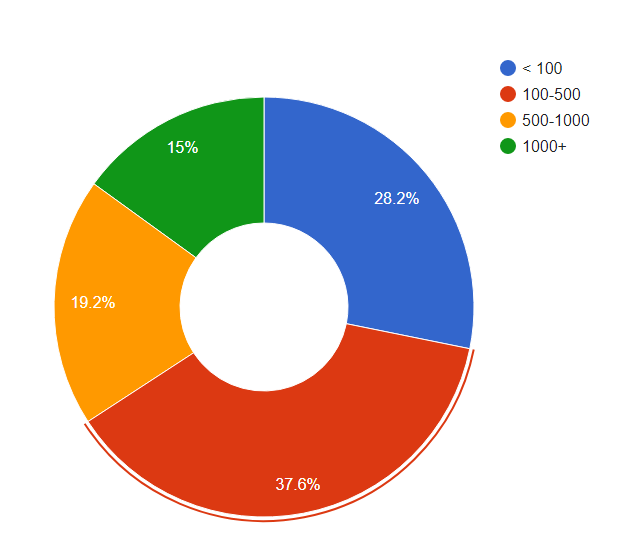
Main Language on Latvian Sites
While it's possible to detect and display content based on user language preferences, most Latvian sites don't do this. Based on analysis:
- Latvian: 66%
- English: 17.8%
- Russian: 4.8%
- Other languages: 11%
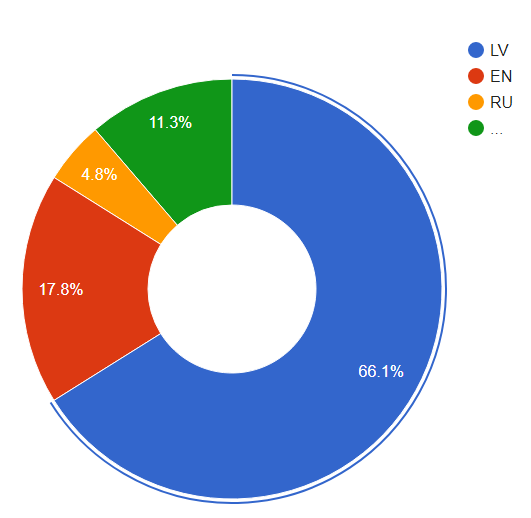
Common Technical Mistakes
Only 8% of the analyzed Latvian sites were free of HTML errors. Below is a summary of the most common issues:
| Error Description | Affected Sites | Avg. Occurrences per Site |
|---|---|---|
| Invalid attributes on elements | 34% | 12 |
Missing alt tags for images | 39% | 8 |
| Invalid element nesting | 35% | 7 |
| Duplicate element IDs | 15% | 8 |
Deprecated attributes (e.g., align, bgcolor) | 25% | 4 |
| Unclosed elements | 11% | 6 |
Use of deprecated font tag | 5% | 12 |
<img> without src | 4% | 14 |
| Element closed without opening tag | 8% | 4 |
| Incomplete structured data attributes | 4% | 9 |
| No spacing between attributes | 8% | 4 |
| Paragraphs closed without an opening tag | 10% | 3 |
| Duplicate attributes | 5% | 4 |
| Incorrectly quoted attributes | 4% | 5 |
Which Latvian Sites Follow All Recommendations?
Is there life on Mars? A similar question applies when asking: how many websites in Latvia fully comply with all the technical recommendations outlined in this study?
To determine this, the following criteria were considered:
- HTTPS availability
- Page download time under 200ms
- First contentful paint under 200ms
- Total page size under 100 KB
- Presence of a
robots.txtfile - Page title (
title) under 60 characters - Meta description (
meta description) under 160 characters - Mobile responsiveness
- A single main heading (H1)
- Fewer than 100 links per page
- No HTML validation errors
Websites were ranked based on the number of images that include both alt and title attributes.
| Place | Site |
|---|---|
| 1 | http://www.nika-lat.lv |
| 2 | http://www.caballero.lv |
| 3 | http://www.rietumkrasts.lv |
| 4 | http://www.panoramariga.lv |
| 5 | http://www.ra.lv |
Conclusions
In nearly all cases, only a minority of websites meet any given technical parameter. Specifically, when assessing by critical factors:
- HTTPS availability: 50%
- Fast loading speed: 30%
- Indexing readiness: 20%
- Mobile optimization: 67%
- Structured data for rich snippets: 25%
- Proper use of titles and descriptions: 35–50%
- No technical errors: 8%
Overall, about 35% of Latvian websites comply with the key technical optimization guidelines. However, when all these parameters are considered together, only five sites meet every single requirement - roughly 0.02% of the total.
Given that only around 20% of companies in Latvia have a website, and assuming an average of 800 competitors in any given niche, we can estimate:
- Number of websites in the niche: 800 x 0.2 = 160
- 1% (rounded from 0.02%) fully optimized: about 1.6 websites
Therefore, based purely on technical factors - and without accounting for content quality - it is possible to rank in the top 3 Google results with relatively modest effort.
Research team
Analysts and strategists focused on uncovering actionable insights through data, trends, and real-world case studies to guide smarter digital decisions in the B2B space.
